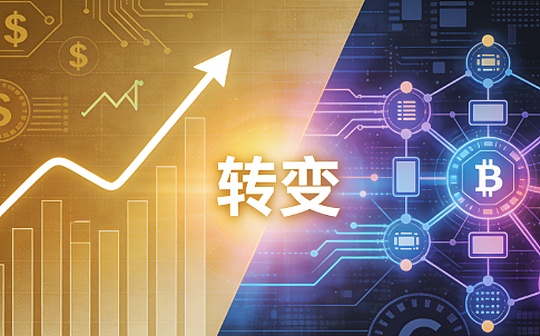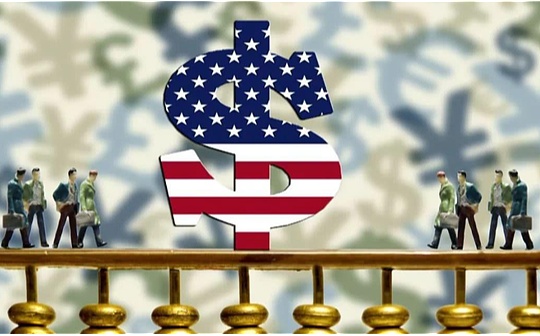
Author: Michael Nadeau, The DeFi Report; Compilation: Wuzhu, Bitchain Vision
We’ve said it many times: If you don’t understand the macroeconomic trends, you don’t understand cryptocurrencies.Of course, the same is true for on-chain data.
This week,We will explore how macroeconomic trends will affect the cryptocurrency market in 2025.
inflation
Inflation data is rising.After bottoming out at 1% in September, we have accelerated to more than 3% by Truflation.
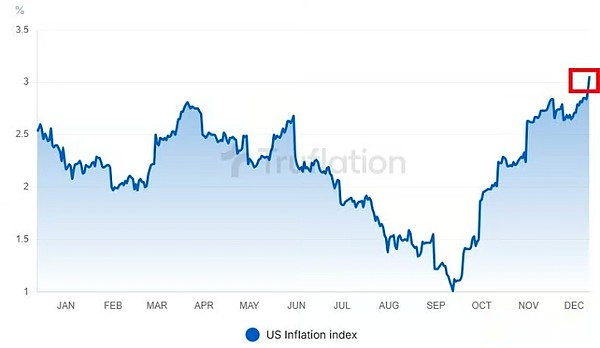
Data: Truflation
We like Truflation’s data because it crawls data using real-time networks from various online sources.Furthermore, it is updated more frequently than traditional government indicators such as PCE.
However.The focus of the Federal Reserve is PCE.Therefore, we use PCE as a way to predict Fed policy and use Truflation to understand the economy more in real time.
This is personal consumption expenditure:

Data: FRED database
Currently 2.3% (October data).It’s also rising – this is hard to see on the chart (2.1% in September).We will get November data on December 20th.
Perspectives on inflation
Energy costs and housing costs are the main drivers of growth.However, crude oil prices are at cycle lows.
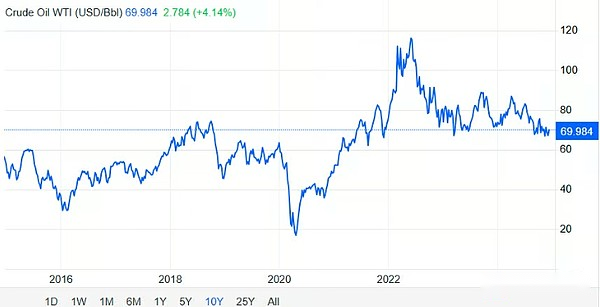
Data:: Trading Economics
The question is whether they will stay here or may drop further.
Given the seasonal impact + Trump plans to increase supply through U.S. deregulation, it’s hard to see why oil prices will soar quickly.
On the other hand, geopolitical conflicts, unforeseen natural disasters or OPEC production cuts (expected increase in U.S. supply) may lead to higher oil prices.
We have not seen these events happen yet.
Furthermore, our position is that inflation has been primarily caused by supply shock + fiscal spending and stimulus checks – which we do not consider today a threat.
therefore,We expect oil prices to fluctuate within the range and inflation/growth will decline.
Dollar
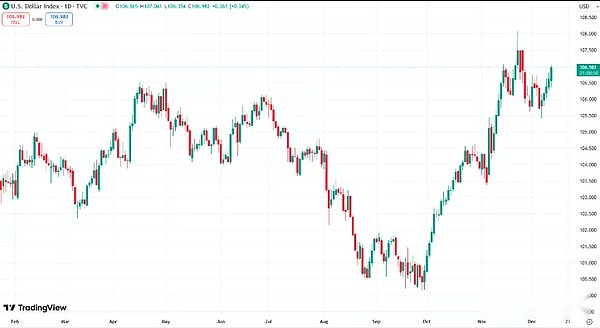
Data: Trading View
Bitcoin has risen 58% since October 1.Meanwhile, the U.S. dollar index rose from 100 to nearly 108.Today’s ranking is 107.
This is a special behavior.Normally,The strengthening of the US dollar is not good for risky assets such as Bitcoin(See 2022).But we now see that the two are strongly related.
So what’s going on?Should we worry?
We believe thatThe dollar is showing strength due to global market pricing for Trump’s victory.Trump’s policies are good for business.This means they are good for the market.
We saw the same dynamic after Trump won in 2016.The dollar rose.Why?We thinkForeigners are digesting the impact of “Trump surge” and therefore purchase assets denominated in US dollars.
Views on the US dollar
We believe growth is slowing/normalizing.This is reducing inflation, albeit with some delays.Interest rates may drop.
Therefore, we expectThe US dollar will fluctuate in the range in the medium term and may fall back to 100.
ISM data (economic cycle)
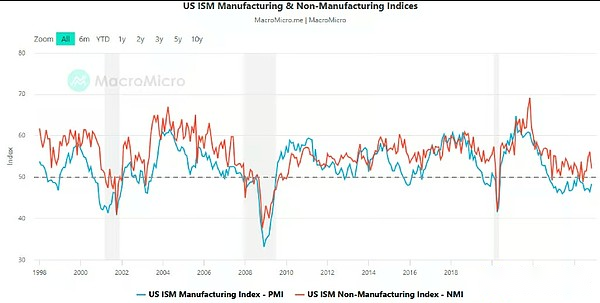
Data: MacroMicro
From the economic cycle, we can see that the blue line (manufacturing) seems to be bottoming out.Historically, readings below 50 indicate that the economy is in a contraction state.Continuing below 50 indicates a slowdown.
This is where we are now—the service (red line) is doing slightly better.
These levels often occur simultaneously with rising unemployment rates.This often leads to the Fed’s adoption of loose monetary policies.
again.This is exactly what we see today.
Views on economic cycles
We believe that slowing growth has led to an increase in unemployment.This may eventually manifest as downward pressure on inflation.
This leads to a rate cut.This puts downward pressure on the dollar.
In the medium term, we believe these dynamics should support risk assets/cryptocurrencies.
Credit Market

Data: FRED
Credit spreads continue to be at historical lows, indicating that investors have low compensation requirements for additional risk units.
This may mean two things: 1) Market complacency, risk pricing errors.Or 2) Market participants are optimistic about the economy, with the Federal Reserve and fiscal policy easing.
We think it is the latter.
Next, let’s take a look at the trend of bank loans.

Data: Fred Database
The proportion of banks that tightened lending standards has been declining since reaching peaks in late 23.Ideally, this KPI will remain stable as the Fed cuts interest rates.
Having said that, historically, we have seen negative correlations with banks’ tightening of lending standards.Why? Rate cuts often herald a slowdown or recession – which makes it harder for banks to lend.
Views on the credit market
There is no sign of stress.At least not yet.
Labor Market
The unemployment rate rose to 4.2% in November (previously 4.1%).Below we can see the recent increase in the number of people applying for unemployment benefits.
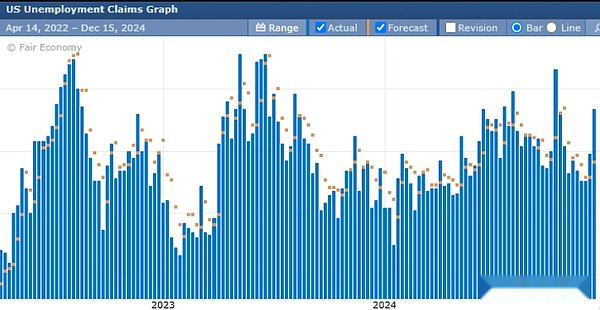
Data: Forex Factory
We believe that the weakness in the labor market has attracted the full attention of the Federal Reserve now.The rising unemployment benefits data tell us that it is becoming increasingly difficult for those who are unemployed to find a job.
This is another sign of slowing/normalization of growth.Having said that, the stock market is still at an all-time high.Corporate profits are strong.This is what keeps the labor market intact.
But my feeling is that the Fed is watching it like a hawkish.After all, Sam’s rule was triggered in July.
Perspectives on the labor market
It is softening.But the speed is not fast.We expect the Fed to (try to) take action before the data weakens (because they have cut interest rates by 50 basis points in September after the release of Sam’s data in July).
Treasury and fiscal expenditures
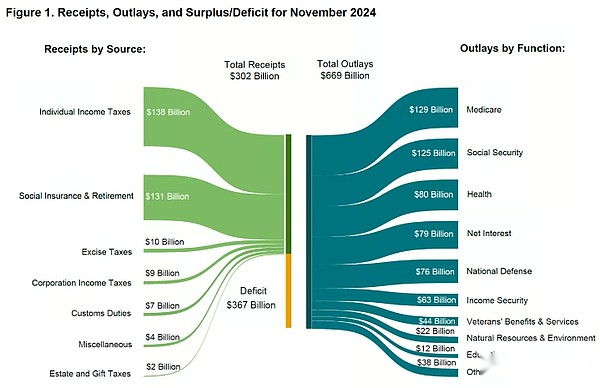
Data: U.S. Treasury Department
The U.S. government spends $1.83 trillion more than tax revenue this year.In November alone, it spent more than twice its revenue.
The $1.83 trillion printed and pushed into the economy/Americans is the main driver of financial markets this year (and we believe are also the main driver of inflation).
Now.Trump is coming.We also have a new agency called “DOGE”, the Ministry of Government Efficiency, led by Elon Musk.
Some people believe that excessive spending will be reduced as a result.Maybe it will.But which departments will be cut?Medicare/Social Security?army?interest?
That’s 65% of the budget—which seems untouchable.
Meanwhile, the Treasury will have to refinance more than one-third of its debt next year.We don’t think they can do this by raising interest rates.
Views on Treasury/Financial Expenditures
We believe that it is unlikely to significantly cut fiscal spending in the near term.DOGE could cut $10 billion in spending.But it will not change the status quo in a substantial way.It takes some time.
Meanwhile, the Ministry of Finance needs to refinance 1/3 of all outstanding debts next year.We think they will do this with lower interest rates.
Combining these views,We are optimistic about the prospects for risky assets/cryptocurrencies.
Federal Reserve Policy
The next FOMC meeting will be held on December 18, with the market currently expecting a 97% chance of a rate cut.We believe this may also give the green light to China’s loose policy.
Why?
We believe China hopes to continue to implement loose policies.But when the Fed does not cut interest rates, it will be difficult for them to cut interest rates, as the yuan will depreciate against the US dollar, making Chinese imports more expensive.
Views on Fed Policy
Rate hikes in the short term seem unlikely.The interest rate cut in December was almost a foregone conclusion, with market pricing suspended at 76% in January.There were no FOMC meetings in February.
Therefore, the next policy decision will not be made until March.We believe thatThe labor market is likely to show more signs of weakness at the moment, with the Fed likely to cut further interest rates in mid-to-late 2025 – ultimately cutting around 3.5%.
Will interest rate cuts exacerbate inflation?We don’t think so – this is a non-consensus view.In fact, we believe that rate hikes are causing inflation (and other fiscal spending) to rise.
Why?
Because interest expenses appear in more than $1 trillion.The money is printed and passed to Americans holding bonds, and it seems to be put into the economy.Of course, rising interest rates did not cause banks to stop lending (see the picture above).
Therefore, we believe that inflation may fall as the Fed cuts interest rates (assuming oil prices remain low and we do not see further fiscal spending increase).Remember, we have implemented zero interest rates for 10 years with low inflation.Japan has implemented a 0% interest rate for 30 years, and the inflation rate is relatively low.
Trump Policy
The market knows what Trump’s presidency will bring:
-
Reduce taxes.This should boost corporate profits and could lead to higher stock prices.It may also lead to increased income inequality and increased deficits.More deficits = Americans have more dollars in their hands.
-
Tariffs/”US First”.This could lead to domestic prices rising.We think AI/automation may actually offset this to some extent.
-
Deregulation.This is good for businesses, as it may lead to higher profits in the energy, technology and finance sectors.
-
More powerful boundaries.This could lead to labor shortages and wage increases (inflation).
Views on Trump’s policy
We believe Trump is generally beneficial to business, free markets and asset prices.The price is that we may see some inflationary impulses.That’s where things get interesting because if inflation returns, the Fed will seek to suspend interest rate hikes or tighten monetary policy.
Of course, we think Trump will try to impose his will on Jerome Powell.Ultimately, we believe that Trump hopes to drive economic development and eliminate some of his debts through inflation over the next four years.This means inflation must exceed nominal interest rates, but that is not the case today.
Finally, given Trump’s support for the digital asset industry (and the incoming SEC chairman), we believe cryptocurrencies will benefit from his administration.
Not to mention the potential for favorable regulations and the potential of Bitcoin strategic reserves in the coming years.
Views on Trump’s policy
We believe thatFrom a market and regulatory perspective, the Trump administration will benefit cryptocurrencies.
China
Dan Tapiero (one of my favorite macro investors) said China is currently deflation (real interest rates are negative).
China’s negative interest rates have curbed U.S. inflation concerns.This makes the dollar stronger (as we see today).
The U.S. rate cut may lead China to cut interest rates too.
Ultimately, it will bring more global liquidity.
Speaking of global liquidity.
Global liquidity
Given that 1/3 of U.S. debt needs to be refinancing next year, we think the Fed may have to step in as the last buyer (QE).
Lower interest rates in the United States will allow China and Europe to relax conditions in some coordinated way.
We believe this will lead to adequate liquidity/collateral in the financial market – cryptocurrency/risk assets are one of the biggest beneficiaries.
These dynamics are consistent with the fourth year of the encryption cycle—the most unstable upward cycle in history.
Summarize
-
Growth is slowing.
-
This has led to labor market turmoil (the Federal Reserve is paying attention to it).
-
This leads to a rate cut (as we see today).
-
This allows China and Europe to relax conditions without sacrificing currency/import.
-
This brings favorable liquidity conditions to risky assets.
This is the future we see.
Considering fiscal spending, the incoming Trump administration, and the fourth year of the cryptocurrency cycle, you can predict the explosive bull market in 2025 (anticipated volatility).
Of course, we will continue to monitor the market and provide you with the latest information from the on-chain data + macroeconomic perspective.
After all, if you don’t understand the macroeconomic situation, you don’t understand your cryptocurrency.

